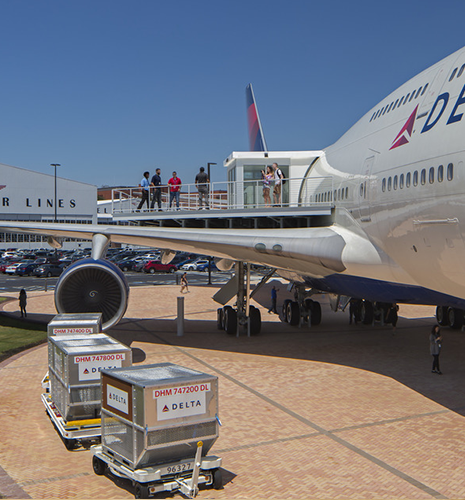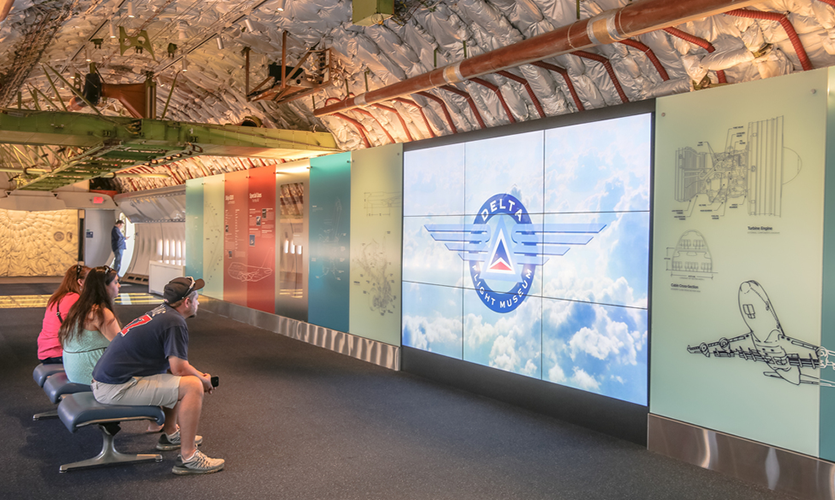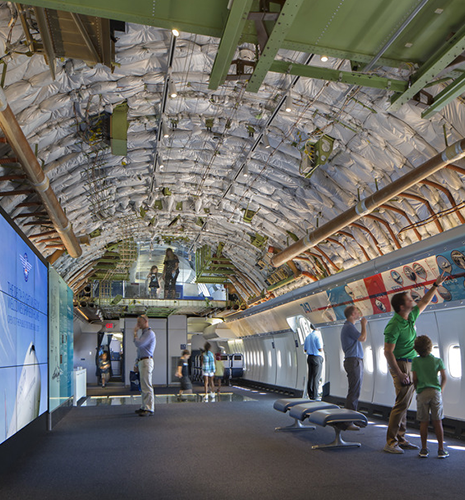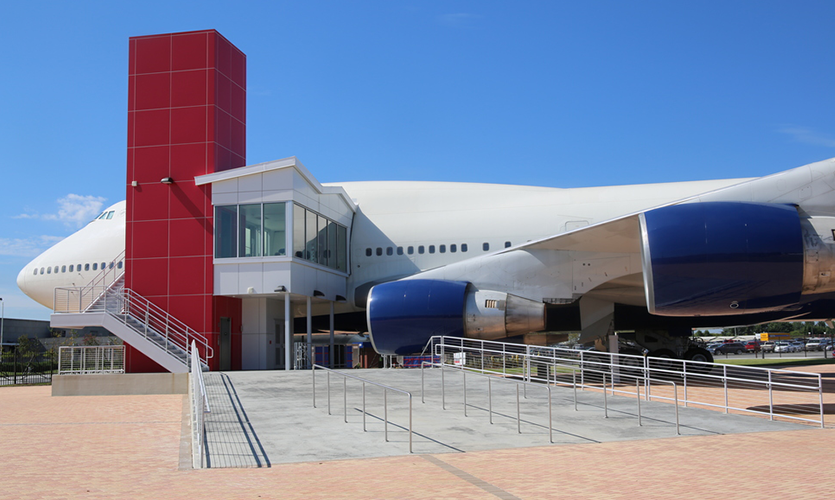Flight Museum – 747 Experience
Delta Air Lines

Continuing in its mission and vision to develop a world-class museum and visitor experience, one that shares Delta Air Lines’ aviation history with the world, Delta Flight Museum acquired Ship 6301, N661US, the first Boeing 747-400 ever built, to support its ongoing goals and objectives. Ship 6301, also known as the “Queen of the Fleet,” having logged more than 86 million miles, was turned into a multipurpose extension of the existing museum, a facility that now includes event space, filming support, and interpretive exhibits.
The siting of the 747-400 required extensive master planning taking into account the airframe’s 232-foot length, 211-foot wingspan, and the existing museum’s facilities, which are located in the heart of the Delta Air Lines’ corporate headquarters. The stature of the aircraft was utilized to create a highly visible entrance to the entire museum with plazas underwing for shading, access to the underside of the aircraft, and other visitor amenities. Providing an engaging and educational venue was the primary goal of the Delta Flight Museum.
The basic planning concept preserved the forward half of the aircraft in an almost existing state. This area was also modified to allow camera tracks and rigging for filming. Guests have access to lay flat seating, galleys, and flight attendant support areas. The back half of the aircraft was stripped of all seating creating a highly flexible multipurpose event space with interpretive panels and graphics. Additionally, all of the interior wall panels were removed exposing the structural, and M/E/P systems of the aircraft. Floor panels were replaced with structural glass flooring allowing for views into the cargo bays and inside the wings. Spot and accent lighting carefully illuminate exhibits and interpretive panels.
The unique and iconic upper-level seating area was also left in its original condition. Access is also provided to the flight crew sleeping quarters and the flight deck cockpit, where one can imagine steering the aircraft from 35 feet off the tarmac.




Have a question regarding our services? Need assistance with an upcoming project? Send us an email. We look forward to hearing from you and will follow up soon.
© SSOE GROUP 1948-2025
Legal | Privacy Policy | CA Privacy Policy | Cookie Policy
Website designed and developed by
Raincastle Communications, Inc.
 Delta Air Lines Lobby and Woolman Café Renovation
Delta Air Lines Lobby and Woolman Café RenovationAutodesk Construction Cloud (ACC) is SSOE’s enterprise-wide project delivery platform. We partner with the Autodesk Product team and have research access. Use of the AI Assistant allows our design teams, owners, and general contractors the ability to query the project specifications for quality, answers, and more rapid responses to RFIs, submittals, or issues.
SSOE has developed a proof-of-concept to use an AI Agent to act as a Master Engineer and Architect trained in SSOE’s processes, best-known-methods, and trainings. Our data structure is being remodeled to enable better use of our proprietary knowledge to train the agent on the ‘SSOE way’.
SSOE is actively piloting AI Chat large language models (LLMs) or copilots that use Natural Language Processing (NLP) to streamline both design and development tasks, transforming how our teams interact with software and each other.
By integrating chat LLM engines into platforms like Revit, we’re enabling users to prompt complex actions using simple, conversational commands. In Revit, this means automating tasks such as modeling elements, cleaning up parameter data, managing annotations and dimensions, and organizing sheets—without writing scripts. These automations and quality prompts can be shared across project teams, accelerating workflows and reducing manual effort.
Similarly, our internal Software Development Community is leveraging GitHub Copilot to expedite coding tasks. Developers can generate and refine code using NLP prompts, tapping into GitHub’s extensive Repo to move faster from concept to implementation.
Together, these tools represent a shift from traditional, expert-driven scripting to intuitive, AI-assisted automation, unlocking new levels of efficiency and scalability across our projects.
We helped our client visualize and optimize façade design for occupant comfort—long before breaking ground through the use of the Autodesk Forma tool. It allows the designer to rapidly experiment with the building’s geometry and façade design to promote sustainability, prioritizing quality of spaces and comfort for end uses, especially in extreme climates (daylighting and microclimate analysis tools) at the project’s exact geographic location, using location-specific environmental data.
Discover how SSOE is using Autodesk Forma to improve sustainability outcomes for industrial projects: SSOE Group: Improving sustainability outcomes for industrial projects with Autodesk Forma.
SSOE is utilizing Microsoft Copilot Edge and M365 to significantly enhance work efficiency and accuracy across various departments. Copilot is accessible to all staff after training. Key areas of application include using it as a writing assistant, for idea generation, document summarization and generation, research assistant, excel assistant, programming code assistant, language translations, product comparison and data analysis. Use of Copilot has become part of the everyday life of SSOE employees who have identified key ways it can help them become more efficient with their daily tasks as well as more accurate in their deliverables.
Today, 100% of SSOE employees have taken the voluntary training and have access to Copilot Edge, achieving early our October 1, 2025 goal.
We found ourselves in need of a more robust tool to enhance resource forecasting and staff assignment capabilities. Instead of waiting for the perfect tool, we’re building it. SSOE’s in-house technology team has developed and piloted a tool that aims to forecast optimal staff mix and duration for new projects against existing workload to better understand capacity and manage resources efficiently. Additionally, the tool will allow teams to identify gaps to optimal staff mix.